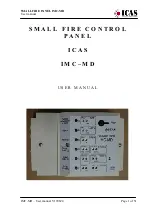
Amplifier
Commutation
Halls Required
AMP-19540
Trapezoidal
Halls required for brushless motors
AMP-19520
Brushed
No
Table 2.4: Amplifier documentation location, commutation, and hall requirements for each internal amplifier.
Pin-outs for the hall signals is found under the ICM being used, refer to Step 7. Connecting Encoder
NOTE
If wiring 3-phased, brushless motors:
Skip
to the additional instructions provided in Step 9a. Commutation of 3-
phased Brushless Motors, pg 18 to find proper commutation.
Step C.
Issue the appropriate configuration commands
Table 2.5 provides a brief list of configuration commands that may need to be set depending on your motor
type and motor specifications.
Command
Description
MT
Configures an axis for use with either a stepper or servo motor
AG
Amplifier gain (A/V for servos or A/Phase for steppers)
BR
Will configure an internal servo amplifier for brushed mode
(Also used to ignore halls when the use of external amplifiers is required in lieu of an
internal)
AU
Configures the current loop update rate
(Can also be used to switch capable amplifiers between chopper and inverter mode)
TL
,
TK
Limits motor command line output in Volts, thus limiting the current in the amplifier
LC
Configures stepper motor current at holding or “rest” positions
Table 2.5: Sample of motor and amplifier configuration commands
Step D.
If using a servo motor, continue to Step 11. Tune the Servo System, pg 23. If using a stepper, continue
on to
Step E
.
Step E.
Enable and use your motor
A SH will enable the internal amplifier and a
MO
will disable the internal amplifier. Once enabled, you can send
DMC motion commands to move the motor, see Chapter 6 Programming Motion, pg 55 for details.
Step 9a. Commutation of 3-phased Brushless Motors
If a motor is not correctly commutated it will not function as expected. Commutation is the act of properly getting
each of the 3 internal phases of a servo motor to switch at the correct time to allow smooth, 360 degree rotation in
both directions. The two most common methods for doing so are trapezoidal commutation (use of Hall sensors)
and through position sensor algorithms (sinusoidal commutation, no Halls required).
The following sections provide a brief description and guide on how to perform either commutation method
including wiring and configuration commands. These sections are divided into Trapezoidal and Sinusoidal:
Trapezoidal Commutation
The AMP-19540 and AMP-19520 support Trapezoidal commutation.
Chapter 2 Getting Started ▫ 18
DMC-42x0 User Manual
Содержание DMC-42 0 Series
Страница 85: ...Chapter 6 Programming Motion 81 DMC 42x0 User Manual Figure 6 14 ECAM cycle with Z axis as master...
Страница 195: ...ICM 2900 PCB Layout Appendices 191 DMC 42x0 User Manual...
Страница 205: ...CB 50 100 Drawings Appendices 201 DMC 42x0 User Manual...
Страница 206: ...Appendices 202 DMC 42x0 User Manual...
Страница 207: ...Appendices 203 DMC 42x0 User Manual...
Страница 208: ...Appendices 204 DMC 42x0 User Manual...
Страница 209: ...Appendices 205 DMC 42x0 User Manual...
Страница 210: ...Appendices 206 DMC 42x0 User Manual...
Страница 211: ...Appendices 207 DMC 42x0 User Manual...
Страница 214: ...CB 50 80 Drawing Appendices 210 DMC 42x0 User Manual...
Страница 215: ...Appendices 211 DMC 42x0 User Manual...
















































